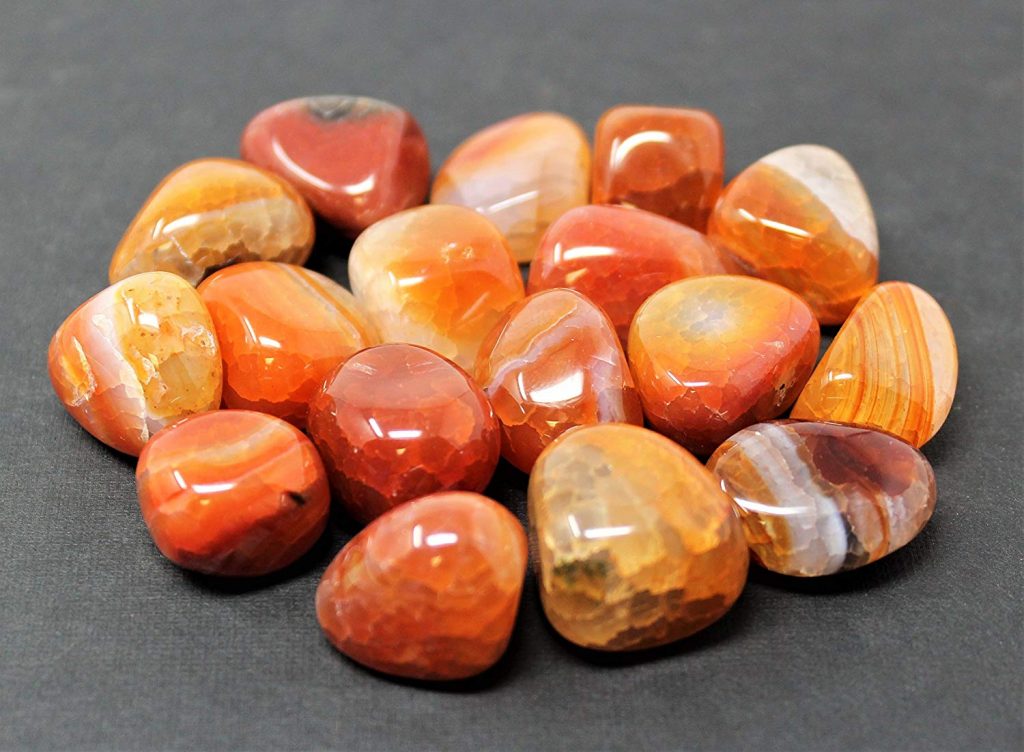
Fire Agate is a layered stone. The layers are small enough that light entering them forms interference colors known as “fire.” The gem is thought to be formed when hot water saturated with colloidal silica and iron oxide invades cavities in country rock and begin to cool. Chalcedony with iron oxide begins to grow on any available surface (the iron oxide gives the basic brown color to the gem). As the solutions began to precipitate and grow layers of silica and iron oxide would be deposited depending on the relative level of those elements in solution and underlying conditions. These alternating silica and iron oxide layers (Schiller layers) cause the brilliant fire in the gem. As iron oxide ran out in the solution colorless chalcedony continued to grow.
Many of these gems are found in the land between Kingman, Arizona and Needles, California, and around the Colorado River. Fire Agate has also been found in quantity in some areas of Mexico.
Treasure Hunting For Fire Agates
Fire Agates is a layered stone that is formed then water that is saturated with colloida silica and iron oxide enters a cavity in a rock and the mineral in the water starts do form new rock. When cutting, the stones layers are ground or polished off following the natural contours of the stone until the desired colored is all that is left. Grind off one to many layers and the stone is ruined.
Searching for fire agates is considered hard rock mining. The agates are usually found embedded in layers of dense limonite and rhyolite rock. Removing these gemstones from the underling bedrock without breaking the gemstones takes time and experience.
Tools required will consist of several different sizes of chisels, a screwdriver, a stiff bristle paint brush, a heavy hammer, goggles and a spray bottle to clean your specimens. After you have found a suitable claim site brush of the area with the paint brush. This will reveal the gemstones embedded in the bedrock. Very carefully chip around the gem with the chisel. Chip to close and the gem will break into pieces, this is where the experience will show.
If you are lucky you will find an seam or even a pocket full of agates. Size and shape of the gemstones has created its own language to describe them. Flowers, dog-tooth crystals and castles are just a few of the names applied to them. Dog-tooth usually is applied to the gemstones that grow from the sides of the pockets and the castles grow from the bottom. Pockets can range from orange to football in size.
The Opal Hill Fire Agate Mine is the only mine that I know of that allows the public to mine for fire agates. It is located in the the Mule Mountains not far from Palo Verde California. Normally when you think of a mine you think of a long tunnel you have to traverse deep into the mountain to find the mineral deposits. The Opal Hill mine is more of an open pit where you can spend $15 to stake your three foot square claim for the day.
The mine owners will take you by the hand and show you what to look for and how to extract the precious gemstones. Once you have mastered the process they will remain in the area for any additional questions or advice. If chipping at rock sounds like to much work you are free to search the tailing area of the mine in your quest for these elusive stones.
Another area that has become quite popular with the rock hounds is the Black Hills Rock-hound area in Arizona. It is open to the public without fees or permits. For more information contact the Stanford district, Bureau of Land Management.
Many of the finished fire agate gemstones do not look like the traditional gemstones that you find mounted in jewelery. Agates are beautifully textured and come in very odd shapes and sizes. Once you see one of these unique gemstones you will see why they have become so popular.
Fire Agates have only been discovered within the last 60 years making them the newest and rarest gemstones on the market today. Fire agates have also been found in Kingman and Golden Valley Arizona, Needles California, Mexico, and areas around the Colorado River. I strongly suggest that you visit the opal hill mine prior to hunting in any other area. This will allow you to see the type of bedrock to look for and what the embedded Fire Agates look like in there natural form.
